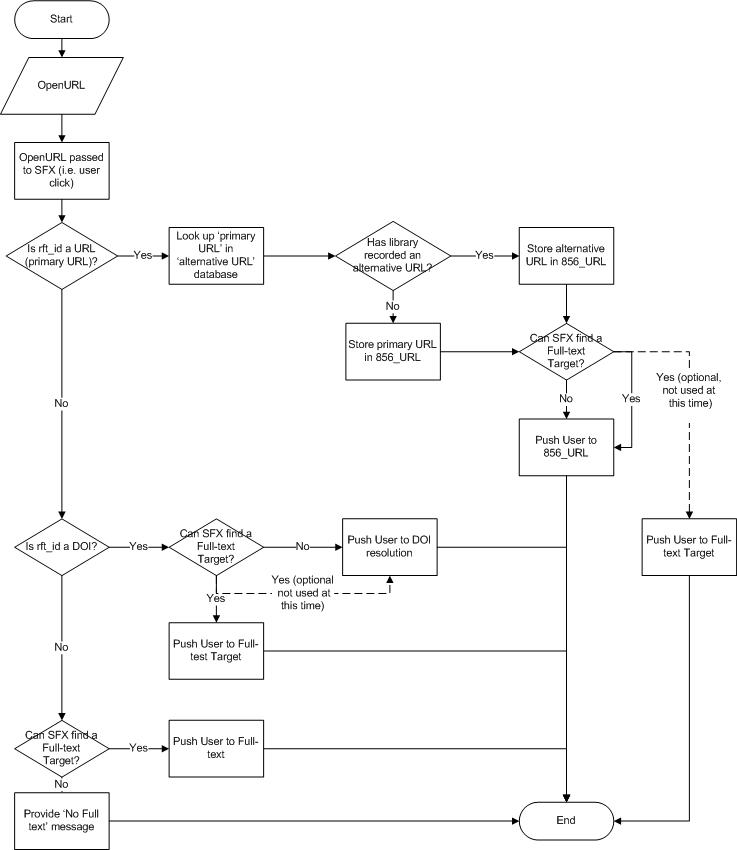6.8.3 TELSTAR approach
6.8.3.1 Underlying principles
When considering future options for linking to resources that are referenced within OU courses TELSTAR established the following principles through conversations with stakeholders:
- Simplification – Currently too many options and systems
- Automation – Avoid manual creation of links whenever possible without having a negative impact on the student experience
- Management – know what resources and links are being used and where
- Transferability – when moving references between different environments, the links provided with the reference should continue to make sense. (see Section 6.8.1 for a fuller explanation)
6.8.3.2 Solution
The solution implemented by TELSTAR has OpenURL at its core. Using OpenURL as a transport mechanism, all links are routed via the SFX OpenURL resolution service. The action taken by the SFX server will depend on the information transported in the OpenURL and the configuration of SFX.
Key to the use of the OpenURL is that the metadata transported in the OpenURL can include identifiers. The two key identifiers for the purposes of references appearing in OU course materials are http URIs (i.e. URLs) and DOIs. Since these are both types of URI, they can be transmitted in the rft_id entity within the OpenURL (the fields available for use in OpenURL are defined in the ANSI/NISO Z39.88 standard http://www.niso.org/standards/z39-88-2004/).
The reasoning used in SFX when resolving an OpenURL is as follows:

As can be seen from this diagram, it is possible to use the ‘primary URL’ (i.e. the URL provided in the original reference), or a DOI, to form a link to the online resource. However, where SFX can form a link to the ‘appropriate copy’ of a resource via its built-in linking mechanisms, we are able to take advantage of this.
In order to enable SFX to use a URI contained in the rft_id entity as a link, a new SFX ‘Source parser’ was written. A Source Parser is a piece of code in SFX that interprets the content of an OpenURL from a specific ‘source’ (the ‘Referrer’ entity in the OpenURL framework).
The diagram above introduces the concept of an ‘alternative URL’ database. This database is a newly developed resource at the Open University Library. When the library becomes aware of a change to a URL which is being used in current course material, an entry can be added to the database recording both the old URL and the new URL. The old URL is then used as a key so SFX can pass any URL to the database to find out if the library is currently maintaining an alternative location for the resource, and the requester will be redirected to the new location.
This mechanism allows immediate action to be taken in the case of resources that move without having to re-edit all occurrences of the resource across all OU course material. However, unlike the current mechanisms, where a resource has not changed URL, no record need be maintained. It also enables the correct ‘primary’ URL for the resource to be recorded with the original reference.
Looking at how this linking mechanism is expected to work for different common material types may help clarify:
Subscribed resources – Journal Articles
In general Journal Articles should be linked to using an OpenURL. This can be generated from the reference metadata.
Where a DOI is available, this should be included in the OpenURL, e.g.:
SFX can then be configured to either resolve the link directly, or pass the user onto the DOI resolution service (e.g. http://dx.doi.org/10.1103/PhysRevE.62.1457) depending on what the library sees as preferable.
Subscribed resources – Electronic Journals
In general Electronic Journals should be linked to using an OpenURL. This can be generated from the reference metadata. If a DOI is available this should be included in the reference metadata.
Subscribed resources – Electronic Books
In theory electronic books can be linked to with an OpenURL, which could be generated from the reference metadata. However, in practice the SFX KnowledgeBase does not contain extensive enough information on e-books and their providers. If a DOI is available this should be included in the reference metadata, and can be used to form a link as with Journal articles.
Subscribed resources – Databases
As these resources have a dedicated URL, it is not possible to meaningfully reference them without including the URL. However, the preferred URL may not be the ‘natural’ URL for the service.
Construct an OpenURL using the supplied URL as an ID (in rft_id in the OpenURL), and then ‘resolve’ it by directing via an appropriate route (e.g. via EZProxy). It might be possible to combine this with information in Voyager (e.g. lookup a URL and get the correct ‘managed’ URL).
Freely available web resources (available via a dedicated URL)
As these resources have a dedicated URL, it is not possible to meaningfully reference them without including the URL.
Construct an OpenURL using the supplied URL as an ID (in rft_id in the OpenURL), and then ‘resolve’ it by directing via an appropriate route (e.g. via EZProxy). It might be possible to combine this with information in Voyager (e.g. lookup a URL and get the correct ‘managed’ URL)
No Comment